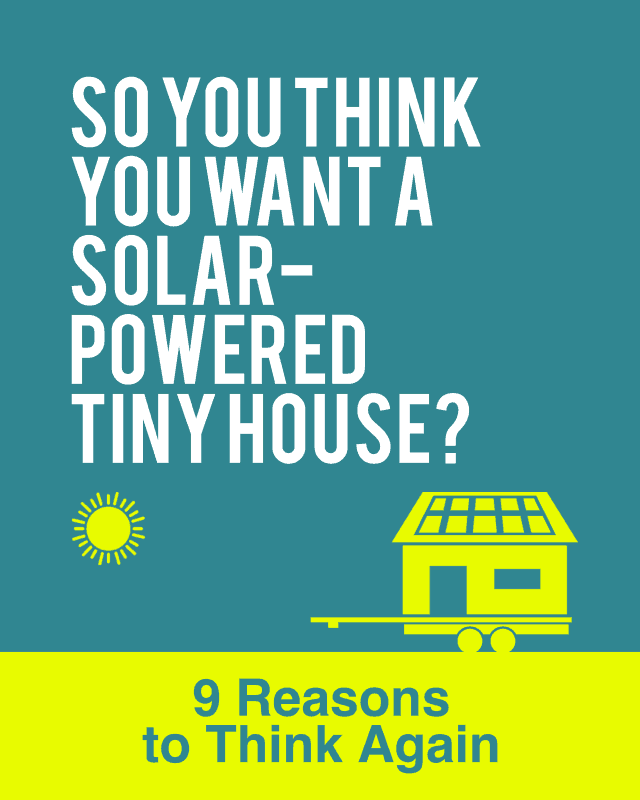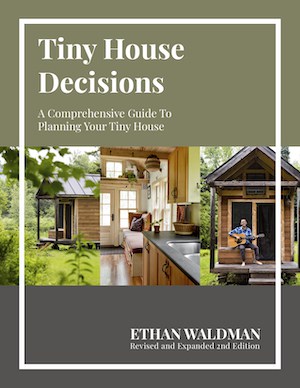Note from Ethan: Everybody makes mistakes. It turns out that this solar tiny house article is probably one of the worst i've ever put out there. Rather than hide it away, I'm including rebuttals to each one of my points below courtesy of Ben Root from the awesome Home Power magazine. You'll see Ben's responses called out in each section of the article. I definitely do think solar energy and tiny houses go well together, so don't let this article discourage you!
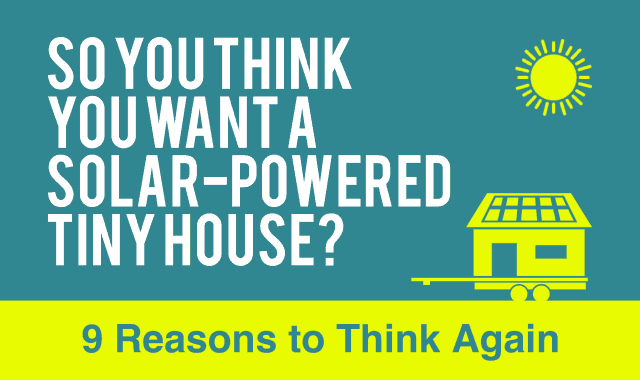
Part of the appeal of tiny houses is the fact that they can enable you to live a more environmentally-friendly and sustainable life. Many people who want to go tiny dream of living in a solar-powered tiny house, using a composting toilet, and perhaps even collecting rainwater to reduce the impact they have on the environment.
Before I started building, I too wanted to build a solar-powered tiny house. But as I did more and more research to figure out how the different pieces of my tiny house would come together, I found out that solar power isn't as simple as you might think.
Because I know so many would-be tiny house owners want to build solar-powered tiny houses, I feel it's important to take a look at the realities of building and living in a solar-powered tiny house. What are you getting into by installing solar panels? How will having a solar-powered tiny house affect your lifestyle? What are the implications of making this decision?
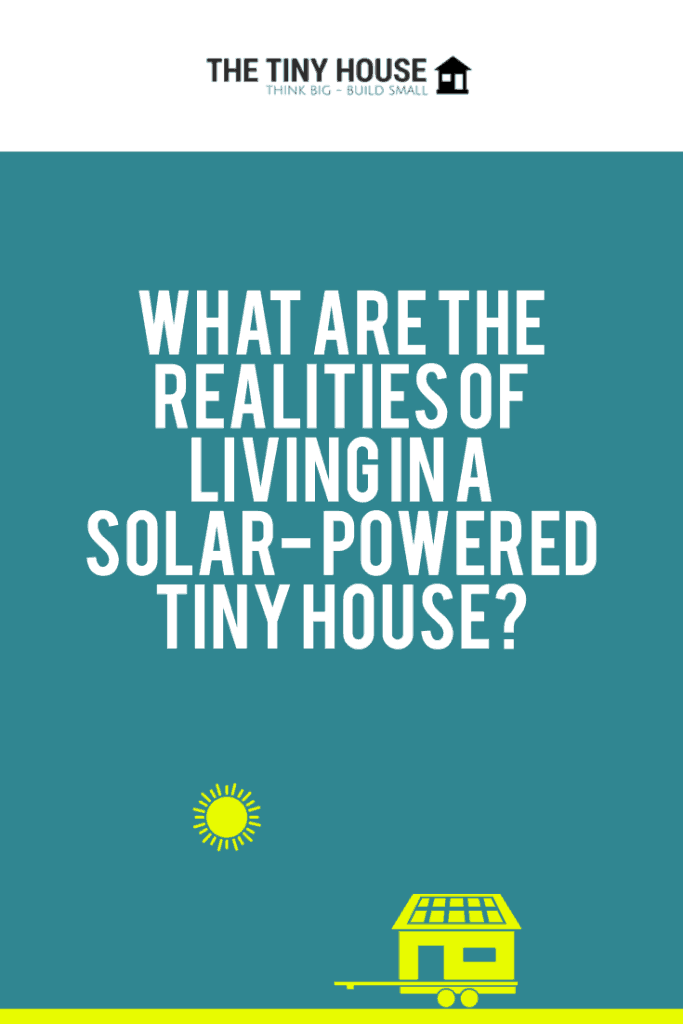
I'm by no means saying that living in a solar-powered tiny house is a bad idea; I'm all for solar power. I just want to make sure you have the facts, so you can make an informed decision about your build.
9 Reasons to Reconsider Building a Solar-Powered Tiny House
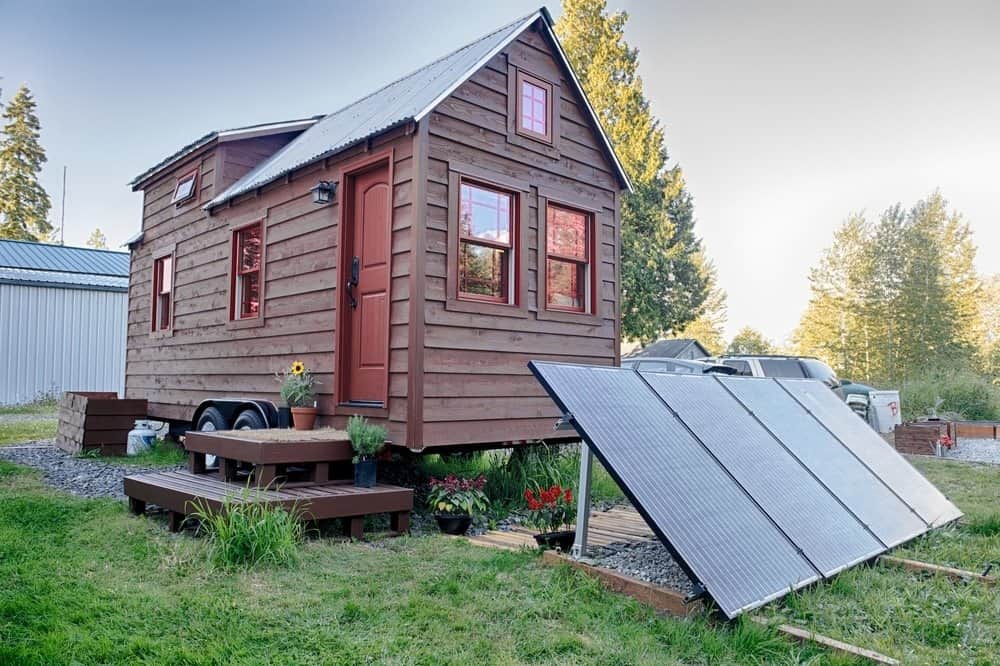
Photo courtesy of Chris Tack
1) You'll need to convert your energy to use regular appliances
Like I said, I initially assumed my tiny house would use solar energy. I knew that solar panels provide DC energy, so I assumed I'd be wiring my house for DC. What I hadn't realized was that, because regular homes (in the USA at least) are wired for AC, all our appliances are designed to run on AC too.
I realized that if I was wiring my tiny house with DC, I was going to struggle to plug in a few important items like my laptop. I'd need to buy special versions of all my appliances. Often, these DC versions of appliances (refrigerators, heaters, etc.) are much more expensive than their AC counterparts.
If your motivation for building a solar-powered tiny house has to do with cost savings, re-buying all your appliances isn't going to sit too well with you. It's also going to hugely limit you in terms of what you can buy for your tiny house. You won't just be able to grab that toaster oven you like or that fancy coffee blender you've heard your friends rave about, because you won't be able to plug them in.
Back in the early days of PV (1980s) the solar pioneers often ran DC light bulbs (think car tail-lights) and car stereos in their off-grid systems. PV was expensive, and these were often poor hippies in the woods, so systems were small and energy use was low. And anything that could be run on something other than electricity was (think propane fridges, and water heaters). The only inverters that existed were from ambulances, were expensive, and were prone to failure. Cabins were small and budgets were low, so DC was the way to go.
Fast forward to the 21st century…PV is cheaper than ever, and inverters are prevalent. You can buy cheap ones at any truck stop, and good ones (true sign wave) are available from small 250W up to 6kW (and are stackable for even more power).
So, no, it would be silly to purchase expensive, but low quality DC appliances and wire your tiny-house for DC.Even RVs and vacation cabins these days have inverters. So why wouldn't you, in your full-time “house” (no matter how “tiny”)?
2) Wiring a house for both DC and AC is complicated
The obvious solution to problem number one is to wire your house for both AC and DC. This is where my mind went next too. Unfortunately there are a few downsides to doing this.
AC and DC can't share the same wires, so I knew going this route would mean installing twice as many wires and outlets. I was already feeling nervous about doing electrical work in my tiny house, so I wasn't thrilled at the prospect of doubling my workload in that department.
Side note: When I was building my tiny house, Ryan Mitchell's excellent Shockingly Simple Electrical had not yet come out. I probably would have felt a lot more confident if I'd had access to this book.
Secondly, to turn the DC electricity from solar batteries into AC electricity, you need something called an inverter. The average inverter is only about 70% efficient. This means wasting 30% of the energy you collect in the solar panels. Again this isn't very efficient at all.
Are inverters inefficient? Well, that depends: Is this a a battery-based stand-alone inverter, or a grid-tied inverter?
Let's start with grid-tied inverters: these are the ones that don't use batteries, and are connected to the utility grid. When you are making more solar energy than your tiny house is using, you send the excess back onto the utility grid and it gets credited to your account. When you are using more energy than your PVs are generating (nighttime, cloudy winter days, or big parties with the stereo lights and fridge all working hard) then you make up the needed energy from the grid and your account gets debited. Basically, your meter spins both ways, and the utility grid acts as your battery.
If you have access to the grid, this is a great way to go. Inverters are cheaper, lighter, smaller, simpler and 98% efficient. Many are even fan-less, for no noise, and transformerless for low EMF (if you worry about that kind of thing).
If you want to be off-grid and independent…that's great too. The inverters are a bit less efficient, but the real efficiency hit is the batteries: lead-acid deep cycle batteries (the cheapest and still most-common alternative) are only about 80% efficient. But that's the price you pay. And you'd be paying that price on an Off-grid DC system running straight from the batteries anyway. It's not the inverter's fault. And how efficient is your alternative: a fossil fuel generator? How quite is running a gas generator compared to sunshine?
Efficiency is a bit of a distraction anyway, the real question is cost per kWh (just like a utility bill).
3) DC appliances aren't great
The other AC/DC issue is that, generally speaking, DC appliances suck. Because most boats and RVs are wired for DC, most DC appliances are designed to be used in boats and RVs. On the one hand, that's great, because boats and RVs are small. However, boats and RVs are normally only used for a few days or weeks in a year, so their appliances aren't designed to work day in, day out.
When I shopped around for DC appliances, I was very unimpressed with their quality. They were mostly of poor quality and made of plastic and other synthetics. Unfortunately, they were also just as (and sometimes more) expensive (than) as regular appliances.
I'm sure if you were determined to live in a solar-powered tiny house, you'd be able to find appliances you liked. You'd just need to do a lot of research and shopping around to get to that point. Again, you won't just be able to buy an appliance because your friend has recommended it. You'll have to seek out high-quality RV appliances instead.
4) Inverters can be noisy
The fourth reason to reconsider building a solar-powered tiny house is that inverters can be quite noisy because of their cooling fans. They're also quite big. If you work from home like me, or if you're particularly sensitive to noise, this might become irritating.
That said, there are ways around this. Chris and Malissa Tack for example mounted their inverter in the front box of their house, on the hitch. If you want to build a solar-powered tiny house, you'll need to think carefully about where to put your inverter. This could affect the rest of your design and limit you in other ways.
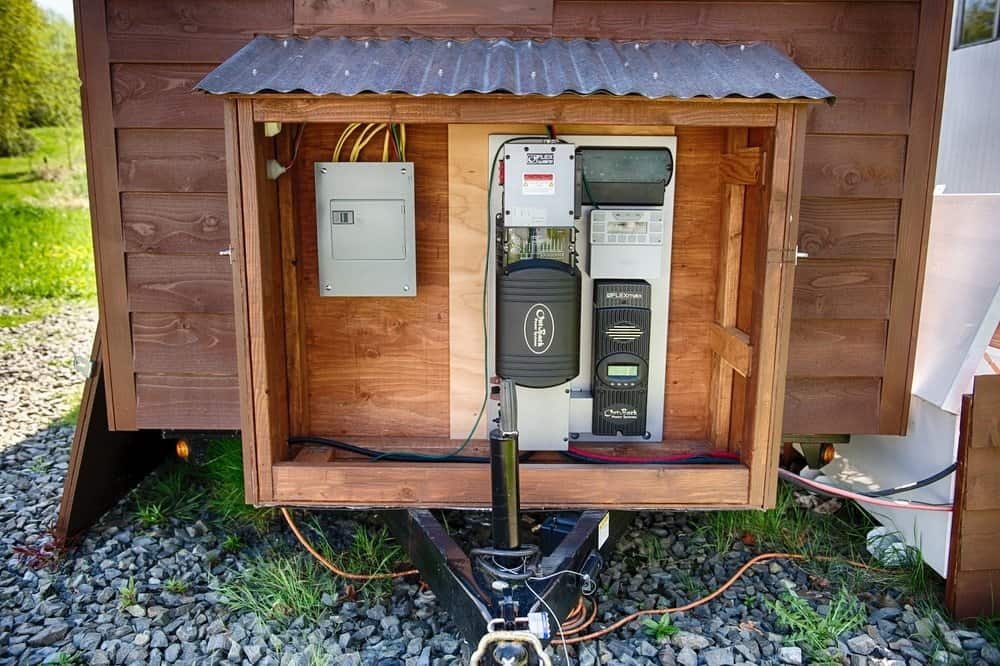
Photo courtesy of Chris Tack
5) There's more to solar power than most people think
When most people think about solar energy, they think of the inverter. But there's a lot more to it than that. You'll also need a charge controller, battery cables, and so on.
You'll also need to really know what you're doing to put everything together. Using Chris and Malissa as an example again, they got a lot of help from both businesses and people they knew.
Whidbey Sun & Wind helped them order the different components, helped them figure out how many panels and batteries they'd need, and supported them over the phone. Chris' father used to be an electrician's apprentice, and so helped them with the wiring. And their landowner is an electrician, so he walked them through things too.
If you don't have friends who have experience with solar energy, you'll probably need to hire an expert to help you. Electricity is dangerous stuff, so you don't want to go wrong. Don't go into this thinking it's easy and that it's just a case of figuring it out. Have a pro to hand.
6) You have to figure out how much electricity you use
Before you can get started with solar power, you have to figure out how much electricity you're going to need. The best way to do this is by working out how much electricity you currently use.
There are two main ways to do this. The first option is to go through your current utility bills, subtracting the energy used by anything you won't be using once you're in your tiny house, like a furnace. The other option is to add up the power consumption of each of the things you will use in your tiny house (your computer, your fridge, your TV, etc.) and to work out how many hours you use them for.
Once you've got those figures, you can use a solar sizing spreadsheet to work out what size your solar system will need to be.
This process can be a little complicated and it's very important that you get it right. If you're nervous about this, consider working with a professional and reading a lot of guides to solar power before you make any final decisions. If in doubt, overestimate the amount of energy you'll need.
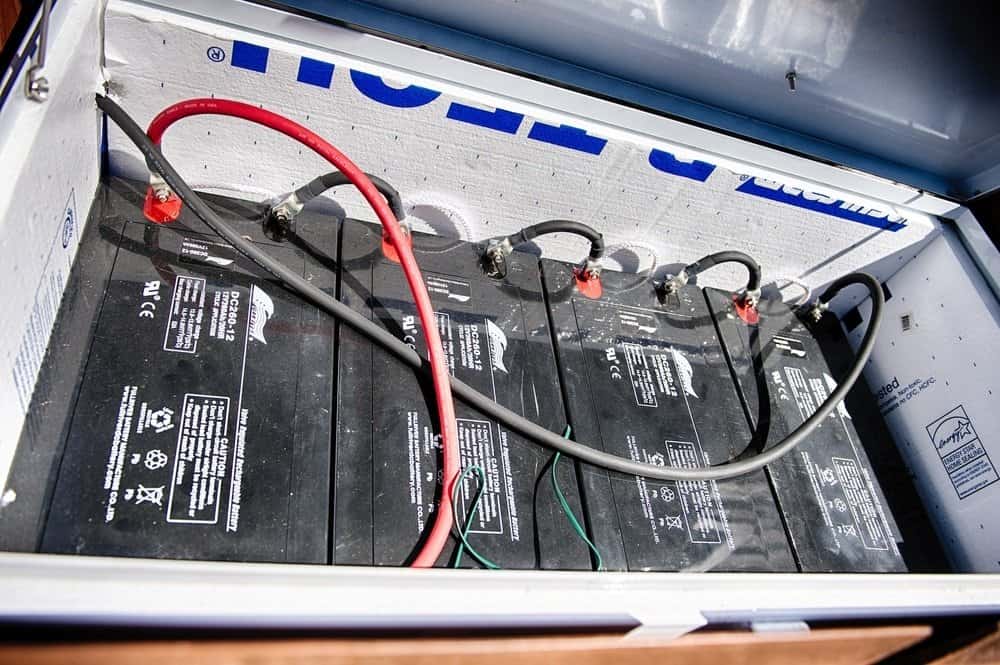
Photo courtesy of Chris Tack
7) You might not get enough sunlight
Depending on where you live and the exact position of your tiny house, you may not be able to get enough sunlight. Even if you can get enough during the summer, you might not be able to get enough during the winter.
This has two main implications. Firstly, it'll determine where you park your tiny house. You'll need to choose land or a parking spot that gets a lot of sunlight. Then you'll need to locate and choose the best spot on that piece of land. This might mean missing out on nice views, being further away from any amenities, and not being able to hide your tiny house from view.
The other implication is that you might need a second energy source, for when there's not enough sunlight. This will complicate your design and build.
if you're choosing the minimalism of living in a tiny house, I'd like to think that your energy requirements will also be scaled-down proportionally as well. What's the point of living small if you're burning electrons like a McMansion? That means that your PV array will likely be smaller than a typical trophy home: It might fit on your roof, or it might fit on a fold down awning, or on a pack-up rack out in the yard. Think about it this way…people use PV panels on RVs, and on sail boats…why not on (or next to) a tiny house?
8) Your solar panels probably won't be able to go on your roof
When you dream of going tiny, you often imagine having everything you need to live in one self-contained unit. But putting solar panels on the roof of your tiny house probably isn't the best idea, particularly if you want to travel.
It's best to be able to place solar panels in whichever spot gets the most sunlight. If you're going to be moving around a lot, that spot is going to be different each time you park up, and you might not be able to manoeuvre your tiny house into it. Having separate solar panels that you can carry into the right spot is much more practical.
Secondly, solar panels take up a lot of space; they might not be able to fit on your roof. To give you an idea of the size I'm talking about, Ryan Mitchell from The Tiny Life uses panels that are 3.3 feet wide and 4 feet tall. You'd struggle to mount those on your roof.
If being able to pack up all your belongings and move to another part of the country at a moment's notice is important to you, solar energy might not be for you.

Photo courtesy of Chris Tack
9) You'll have to clean your solar panels regularly
You can't relax once you've set up your solar power system. You'll also need to maintain it, mostly by keep your solar panels clean.
You know how annoying it is when birds do their business on your car? They're now going to be doing it on your solar panels. Snow, branches, twigs, and other random bits and pieces will all build up on there too, so you'll need to make cleaning a regular activity. Are you prepared to wake up to no electricity on a snowy morning and have to head outside to clear it first thing?
The other thing to bear in mind here is the position of your solar panels. If they're on the ground, cleaning them shouldn't be too difficult. But if they're on your roof, you'll have to climb up onto it. Now imagine doing that when it's covered in snow and ice…
Still Want a Solar-Powered Tiny House?
My goal in writing this article was not to persuade you that solar energy is bad or anything. I just want to make sure you understand the pros and cons of solar energy, so you know what you're signing up for if you do decide to go with it. Hopefully I've given you a few things to consider.
If you're still as determined as ever, good for you. The tiny house movement is all about making conscious decisions and being purposeful in the way you live, so it's great that you know what you want.
If you do want to go ahead with solar power, I'd recommend doing a lot of research to find out about other tiny house owners' set-ups. Here are a few great places to start:
- The Tiny Tack House: Our Electrical System
- Tin Hat Ranch: The Ultimate Guide To DIY Off Grid Solar Power
- The Tiny Life: Tiny House Solar
- TinyHouseBuild.com: I Get My Electricity From The Sun
- Shockingly Simple Electrical
My Decision
I ultimately decided to wire my house completely AC. So far, I’ve been very happy with this decision. The beauty of my system is that I’ve designed with solar in mind: propane appliances, LED and CFL bulbs (that use very little electricity) everywhere. When it’s time to switch over to solar, I shouldn’t need a giant solar array or battery bank.
Whatever you decide to do, make sure you're informed and work with a professional if you're unsure. Good luck!
Do you plan to use solar power in your tiny house? Do you feel like you have a good understanding of what that entails?
